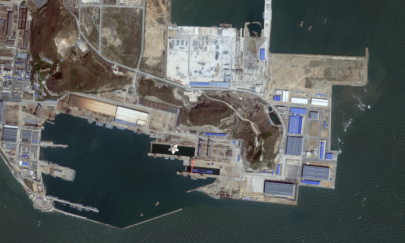China May be Retrofitting Nuclear Submarine with New Missile System
Recent satellite images provide a rare glimpse into China’s naval development as a commercial satellite caught a Chinese submarine in a dry dock for apparent upgrades. It is unclear if the submarine is a new type of vessel altogether or an upgraded class of nuclear-powered attack submarine.
Images taken by private satellite imagery provider Planet Labs show the submarine in dry dock in Huludao Port in Liaoning province some weeks ago. The submarine was out of water from April 24 to May 4, before being resubmerged.
The parts of the vessel behind its superstructure and stern were shrouded with a cover, effectively concealing the area where missile launch tubes or a new, more silent propulsion system could be.
The images were too limited to identify the vessel definitively, but it appears to be a Shang-class, Type 093 nuclear-powered attack submarine. The Type 093 is colloquially referred to as a “hunter-killer” for its combat role in seeking out and destroying other naval vessels, and weighs about 7,000 tons, making it marginally more lightweight than the U.S. Navy’s Virginia-class submarines.
China’s naval force, the People’s Liberation Army Navy (PLAN), has been evolving its submarine fleet over several years to tackle a growing range of potential demands including the protection of its burgeoning aircraft carrier fleets to hunting down enemy ships. The possible appearance of a vertical launch system (VLS) for guided missiles, however, could significantly augment the PLAN’s capabilities by introducing increased range and accuracy to the missiles used by its submarines.
Chinese state-run media China Daily wrote in 2015 that future iterations of the Type 093 would have VLS capable of launching China’s YJ-18 cruise missile.
A report (pdf) released by the Pentagon in November warned that the PLAN was introducing VLS to a number of its surface combatants, and said that it would also soon have the capability to engage enemies at long range using its submarines.
“In the near-term, the PLAN will have the capability to conduct long-range precision strikes against land targets from its submarine and surface combatants using land-attack cruise missiles, notably enhancing the PRC’s global power projection capabilities,” the report said, using an acronym for China’s official name. “The PRC is enhancing its anti-submarine warfare capabilities and competencies to protect the PLAN’s aircraft carriers and ballistic missile submarines.”
“By the mid-2020s, the PRC will likely build the Type 093B guided-missile nuclear attack submarine. This new Shang class variant will enhance the PLAN’s anti-surface warfare capability and could provide a clandestine land-attack option if equipped with land-attack cruise missiles.”
The revelation coincides with the release of another set of commercial satellite images taken by Maxar Technologies over western China’s Taklamakan Desert. Those images revealed a previously unknown missile testing site which suggested that the Chinese military could be experimenting with new, more accurate missiles intended to launch a first strike against enemy ports.
The PLAN maintains the largest navy in the world, with more than 355 ships and submarines, including more than 145 major surface combatants. Among those are six nuclear-powered ballistic missile submarines and nine nuclear-powered attack submarines.
Importantly, the apparent appearance of a Type 093 submarine in dry dock is consistent with Pentagon assessments that the PLAN could work to retrofit its existing nuclear attack submarines with new weapons rather than build new submarines from scratch.
“The PLAN could also retrofit its older surface combatants and submarines with land-attack capabilities as well,” the November report said.
“The addition of land-attack capabilities to the PLAN’s surface combatants and submarines would provide the PLA with flexible long-range strike options. This would allow the PRC to hold land targets at risk beyond the Indo-Pacific region from the maritime domain.”
Such a development would be in line with ongoing efforts by the Chinese military to develop a fighting force capable of ejecting the United States and its allies from the Indo-Pacific, or else of deterring Western powers form interfering in its regional conflicts.





